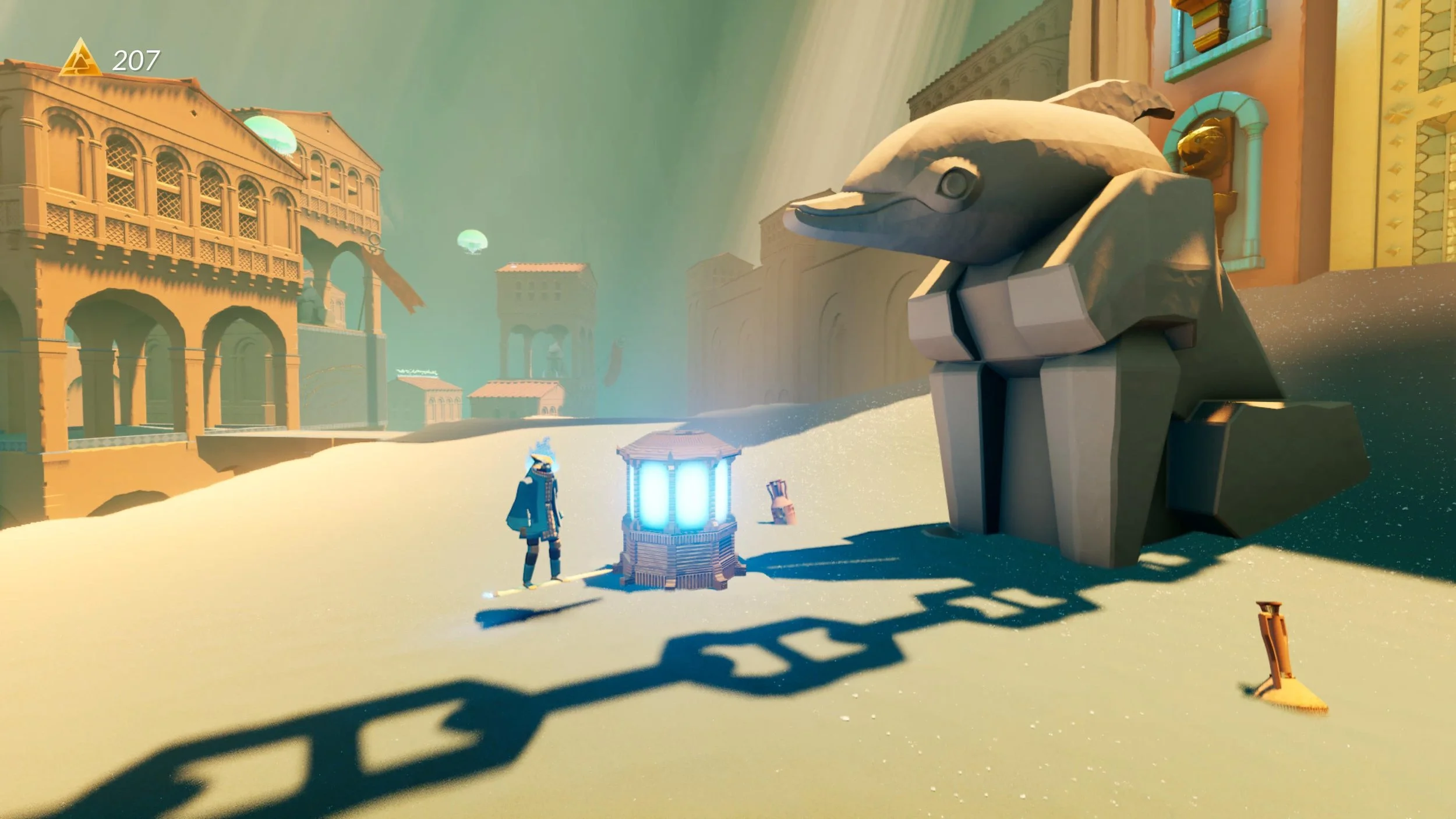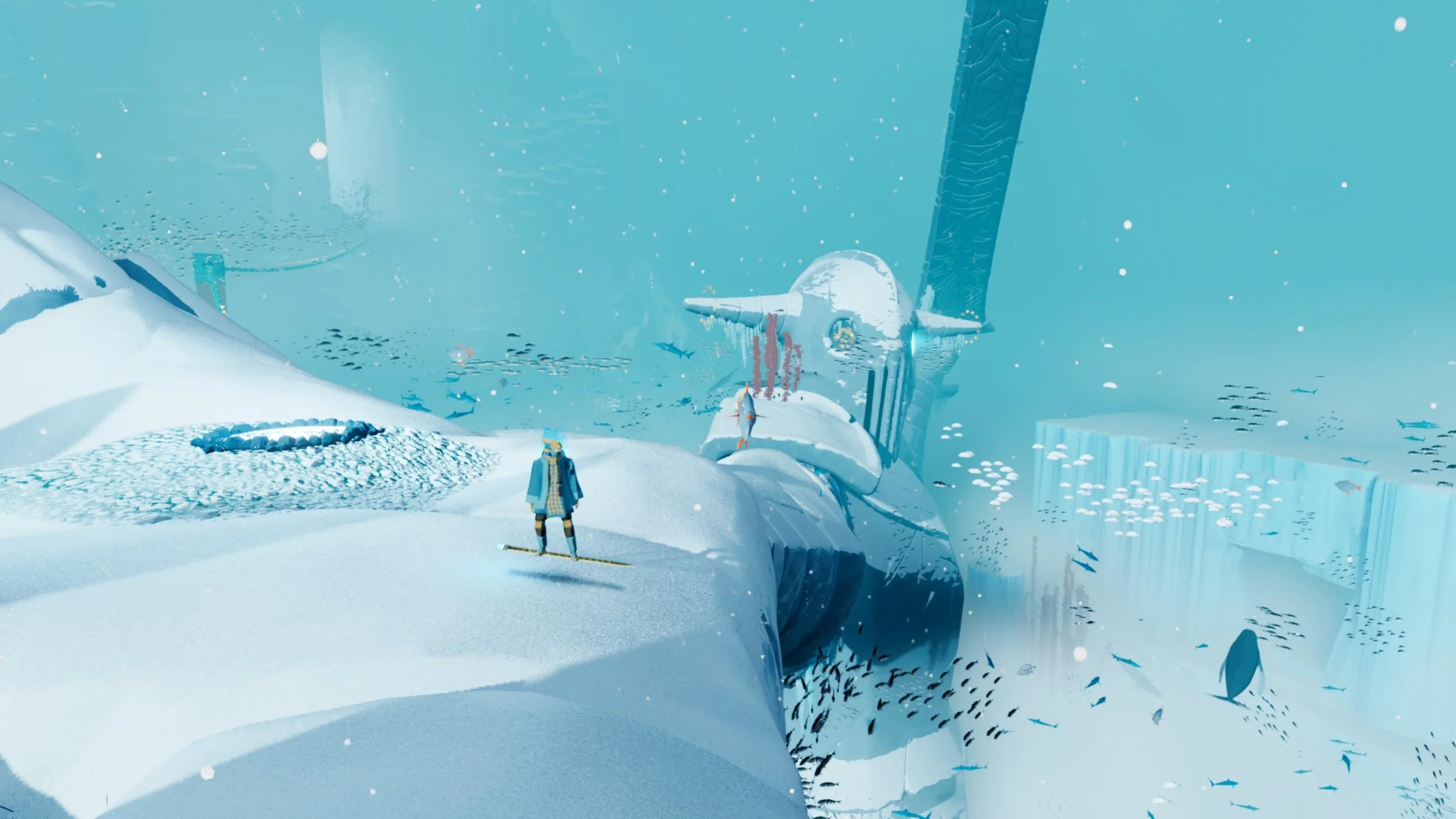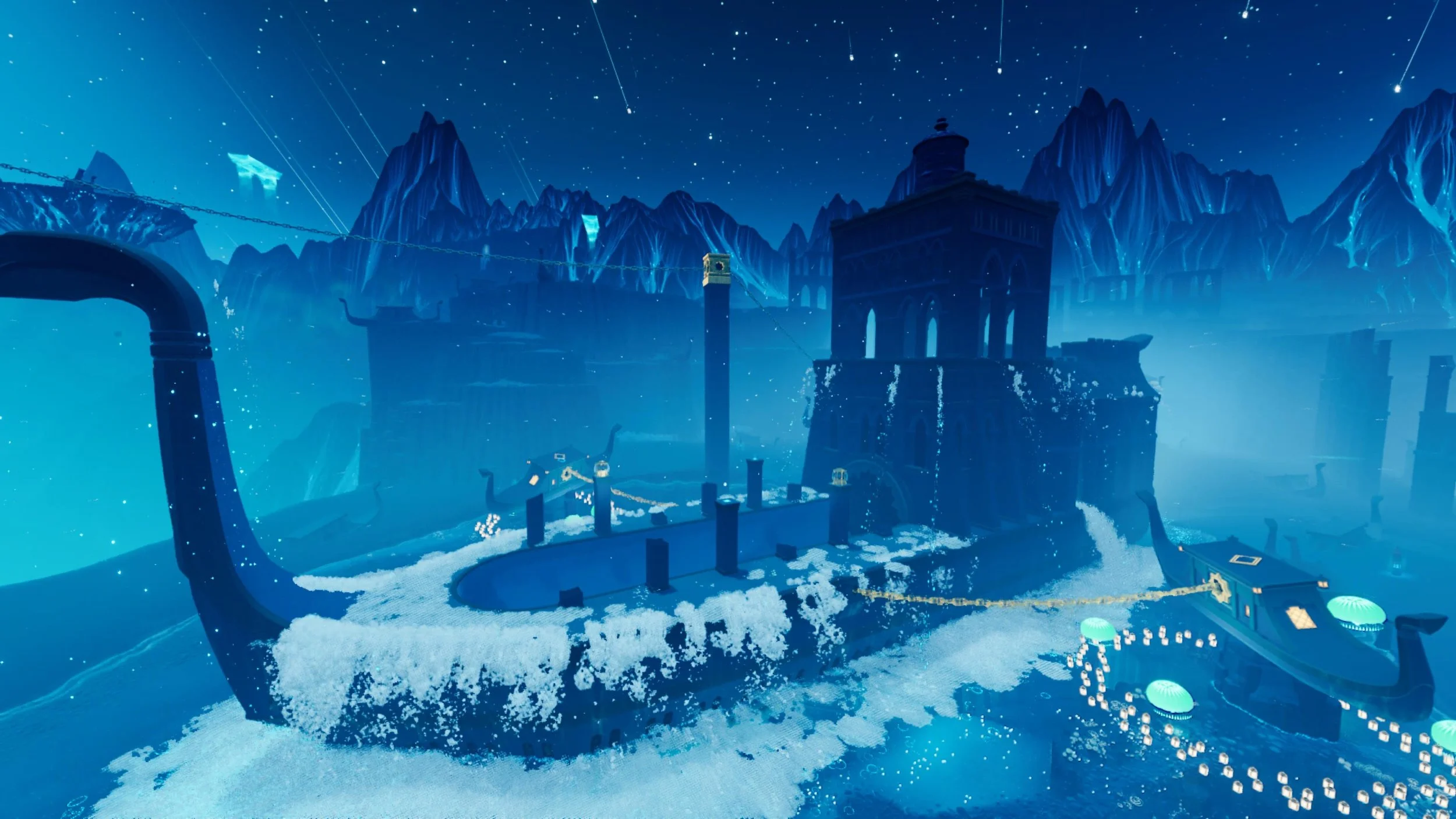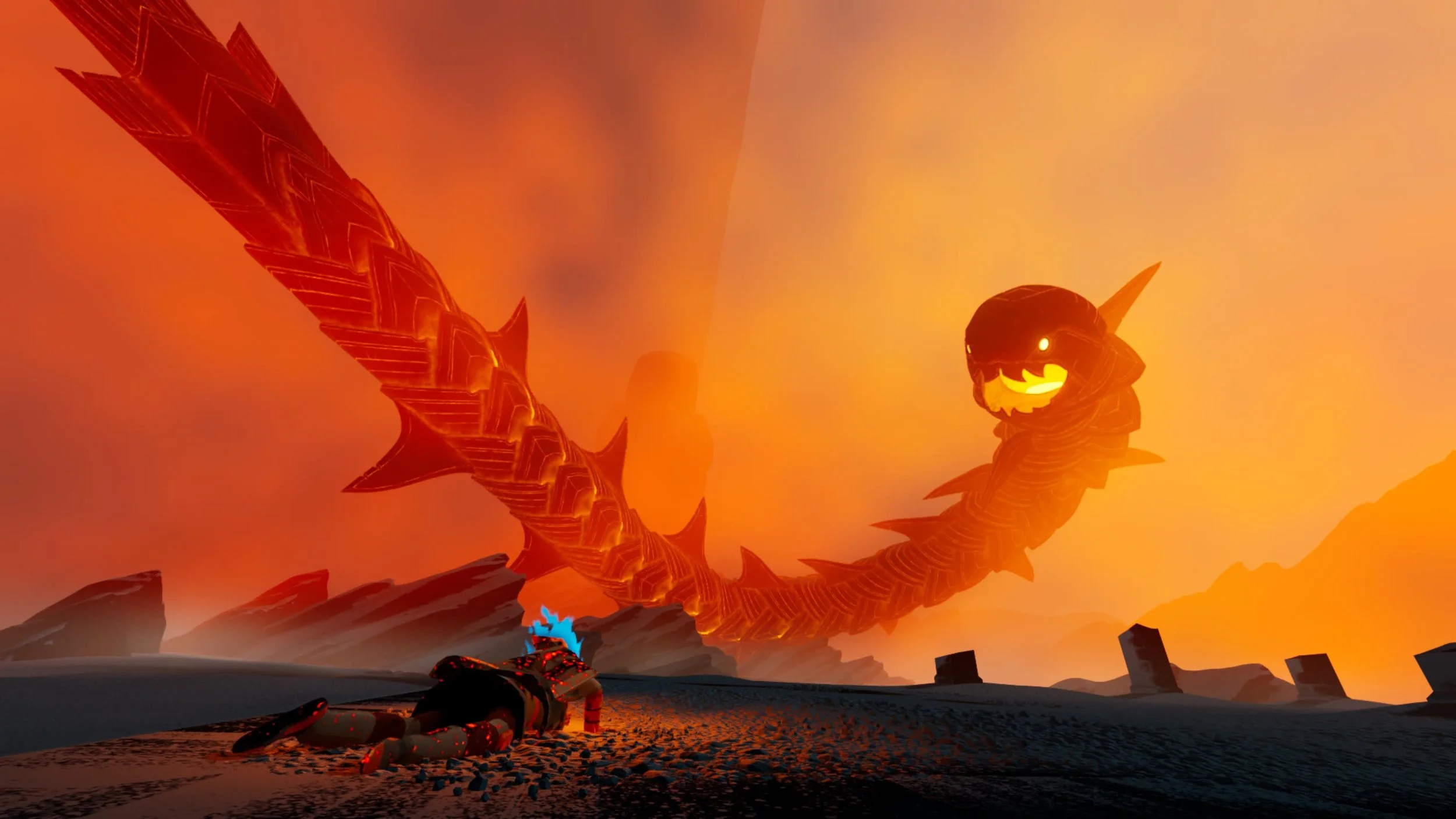Sword of the Sea
Played on PS5 | Original Release Date 19 August 2025 | Review Date 13 October 2025
OVERVIEW
I would like to say that I’m the type of gamer that actively seeks out unknown games on a regular basis. Given that I don’t have oodles of time to play as many games as I’d like, I find myself giving attention to games that I’m fairly certain I’m going to enjoy, or franchises that have a decent chance of providing an expected level of entertainment based on their pedigree. One of the things I’m discovering as Out of Sync Gaming grows and I write more reviews, is my developing curiosity for playing completely unknown titles or finding gaming studios that I, in the past, would have not given as much of my gaming attention to. And if there was ever a case for why it’s a good idea to give a game a chance so you can discover an absolute masterpiece, Sword of the Sea is it!
STORY
Sword of the Sea is a story of discovery and regeneration. It’s also a story with very little actual story telling. You play as a Wraith, a statue, seemingly frozen in time amongst an army of Wraiths statues in a cave within a desert. You are awaken and animated by a single drop of water that hydrates you and your sword or hoverboard, or skateboard, or skate-sword? Let’s go with skate-sword.
From here you venture out of the cave into a vast open areas that are barren of life with deserted buildings and temples - relics of a forgotten time. As you explore the world you discover water elements, and once activated, they bring the environment back to life, restoring the surrounding areas from drab desserts or barren snow laden areas to ones that are full of lush sea plants and animals. This simple, yet powerful theme of restoration and rebirth is what drives the story forward. We don’t fully understand why the Wraith is tasked with this journey, or what happened to this world, but clues are discovered along the way that point to a epic battle between larger than life beings from a forgotten time.
You could play through the game and never read one of the story tablets that are placed throughout the environments and you’d still have a great experience. And part of the fun of the journey is uncovering what happened in the past. I’ll refrain from diving into story details in this review as I found this aspect of the game one of the highlights that drew me deeper into it and had me searching the environments for as many clues as I could find.
GAMEPLAY
I love when a game developer has the courage to simply drop you into an environment and doesn’t hold your hand or tell you what to do. I also applaud a game that has simple mechanics that are easy to pick up, but also have a depth of mastery to them. Sword of the Sea mostly masters this balance, but it’s by no means a perfect mastery.
Sword of the Sea is ‘Jumping Jack Flash meets Ecco the Dolphin meets Tony Hawk meets SSX Tricky meets The Legend of Zelda: Breath of the Wild meets Shadow of the Colossus meets Cocoon. The developers at Giant Squid managed to pull inspiration from all of the best aspects from these games but at the same time make a unique experience that give you the freedom to play the game how you’d like.
The main mechanic of the game is to surf around the environments on your sword, discovering the aforementioned water based elements that regenerate an area back to life. Once it’s regenerated you uncover the pathway forward to the next area you need to unlock to progress the game. You also uncover other mysteries or puzzles that challenge you to use your skateboard-like abilities to find secrets, gain access to hidden areas or collect golden Tetra as your reward. The golden Tetra you collect are donated to a mysterious character who pops up throughout the game - think Hestu from Breath of the Wild or Tears of the Kingdom. Donate enough Tetra to this mysterious being and you’ll learn new tricks which aid you in your exploration of the environments.
This gameplay loop is very well paced. In my first play though of the game, I found myself wanting to regenerate ‘just one more’ area before putting the controller down. This resulted in sinking an hour or so into the game when I was only going to play for twenty minutes or so. It’s simple yet addictive and gives you a feeling of meaningful progression at a pace. Similar to this year’s brilliant Donkey Kong Bonanza, you can jump to the next objective pretty quickly, or stick around and explore all an area has to offer before moving on.
Like Breath of the Wild and Tears of the Kingdom, Sword of the Sea - if you see something, you can probably get there, and it will most likely result in a rewarding reason for platforming your way to the destination. It’s this sense of exploitation and discovery that has me coming back for more. I don’t often revisit games once I’ve finished them, but Sword of the Sea has so many interesting areas I want to discover that I’m working my way through each area again to try and find all the secrets and restore all areas back to life.
There are no enemies that you encounter as you go through the game, except for the final boss. The game doesn’t need them to provide challenge and tension. The difficulty is using your skills to explore the world. You’re challenged with scaling large sections of platforming to gain access to a switch that completes a puzzle that opens a new area or challenge. This can include grinding off of huge chainlink structures, using a sunken ship as a halfpipe, bouncing off a series jellyfish that catapult you higher and higher upwards to the platform you need to reach in the sky, or riding on the back of a dolphin at high speed to master vast open areas. All of this felt perfectly natural and easy to manage because of the tight controls.
Sword of the Sea sticks the landing with the controls. At the start of the game you can jump, do simple tricks and use your board to break things in the environment for more Tetra and activate objects that have a glowing orb around them. As you progress through the game you will earn more complicated tricks that you can use to help you platform to other areas as well as abilities that require more complex timing, requiring you to chain together new abilities. The later half of the games platforming never get’s too hard, but it does create a good sense of challenge that made me feel like a bad ass every time I strung together my abilities on tight platforming sections.
Where the game can demand more of the player is when using the environments to your advantage to gain height or by catching a sand wave at just the right time to give you the boost you need for a jump to a normally out of reach platform. And as you make your way through the game you’ll earn new abilities, tied to story beats, which you must master to progress the story. However, I wish the tricks that you unlock with the Tetra served more of a purpose. You can complete the game and never unlock a trick, so I never really felt compelled to fully unlock all the hidden abilities. The main story culminates in a super fun boss battle that requires you to use, most of, the skills you learned throughout the game to beat it. I say ‘most of’ because the additional tricks you unlock served no purpose here, or at least I didn’t need them to finish the game.
One thing to mention about the controls is I played on PS5 and boy-oh-boy this game really uses the Duel Sense’s haptic feedback for immersion. Every surface of the game has a unique sensation brought to life with the controllers haptics. It really immersed me in the overall experience of the game, probably one of the best examples of why this isn’t a gimmick, very cool!
Sword of the Sea a short game. My first play though was under four hours. But the longevity and replay-ability comes in the post game. Once you complete the main story, you get a message telling you how quickly you beat it - I can’t wait to see what speed runners do with this game! You also get the ability to select which area you’d like to go back through to unlock all the secrets and regenerate all water areas. I think it’s because of the shorter game length and the fact that there are no enemies, that I find myself going back through each area. It’s a real joy to simple discover secrets and hidden areas within each world without the pressure of stopping to fight an enemy or worry about dying or feel some sort of time pressure to get through to the next area. You can simply chill out in the environment, do some cool platforming and unlock all the game has to offer at your pace. And you’ll want to go back because the game is beautiful!
GRAPHICS
The team at Giant Squid have used a simple yet elegant graphic style the game. There are nods to cell-shaded graphics, but they are reserved and never over stylised. In fact a lot of the game, in my opinion, is a little under stylised. But I think it works, because the effect of regenerating an area that is barren, and seeing the sea life and ocean spring into existence makes everything visually sing. It’s such a feast for the eyes that never gets old. There are plenty of variety in the environments from the first desert area, to a frozen tundra, to bright areas full of lava and fire and all the areas pop with visual flair and diversity. I often found myself wanting to reach certain areas within a world so I could simply see all the environment has to offer visually. Just magical!
The way the game uses scale is awesome. The camera really serves to create dynamic environments by shifting from tight and up close moments in some areas and then panning back in others to the make gameplay feel different and fresh. The development also use some fun camera positions to show off their stunning environments - they know they have something beautiful here and they want to make sure you take it all in. Each beautiful environment is coupled with a standout score of music that is perfectly executed.
MUSIC / SFX
Austin Wintory has composed of the most effective music scores for a video game I’ve played in a long time and is perfectly matched for Sword of the Sea’s game play and world building. Each song is haunting and evocative of the environments that you explore. There is a sense of loneliness that the music creates, but also a sense of hope. Austin uses a mixture of choir voices and instruments that blend effortlessly into the game’s environments and action moments that draw you in and elevate the story telling. The songs provide emotional clues to what’s happening during the game as well as serving as atmospheric background music to bring the world to life. I don’t typically listen to gaming music on its own, but since playing Sword of the Sea, and in fact as I write this review, I’ve been listening to the soundtrack. It’s just beautiful and a real stand out aspect of the overall experience.
CONCLUDING THOUGHTS
Sword of the Sea surfed right into my heart and put a big smile on my gaming face this year. The team at Giant Squid have a little masterpiece on their hands and this game stands out as an absolute joy in a sea of gaming that can often feel too long or overly complicated. Its a tight gaming package that feels epic in scale, with brilliant controls and just the right amount of mystery and intrigue to draw you into it’s beautiful and haunting world. It’s by no means a perfect game, and I suspect there will be gamers out there that might find it’s lack of challenge a turn off. But if you’re looking for a game you can pick up and play without a lot of mechanics to understand, but a lot of fun to master, Sword of the Sea is exactly what you’re looking for. And if this doesn’t sound like a game that you’re interested in, at least do me a favour and listen to the soundtrack, you’ll be happy you did. But for me, Sword of the Sea pulls all the best inspiration from a vast array of different games and still manages to feel unique and fresh, and earns it’s place as one of my favourite games I’ve played in a very long time.
OUT OF SYNC GAMING REVIEW SCORE | 10 out of 10
What do you think of Sword of the Sea? Share your thoughts and comments below.








